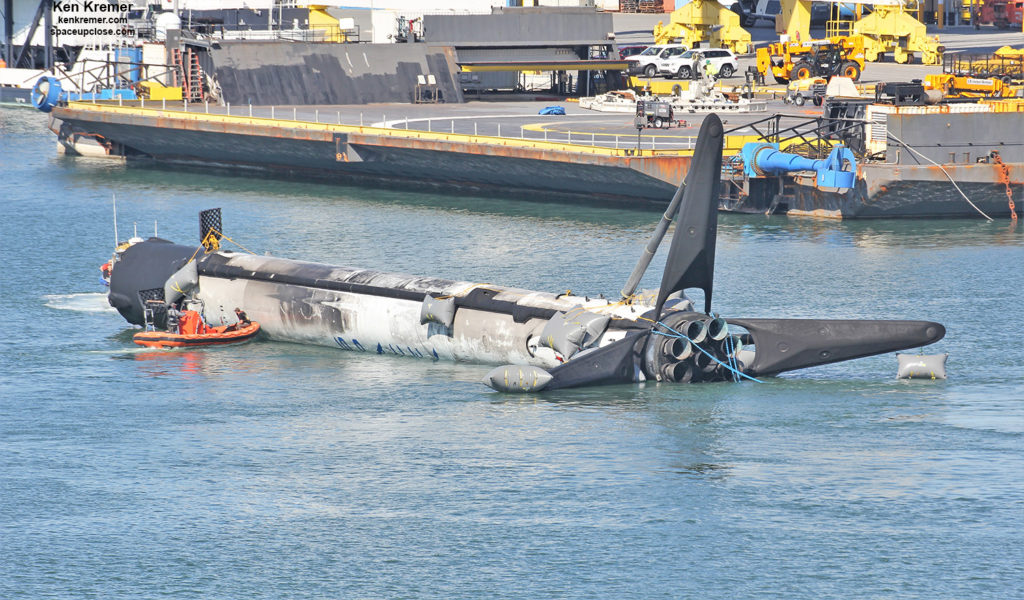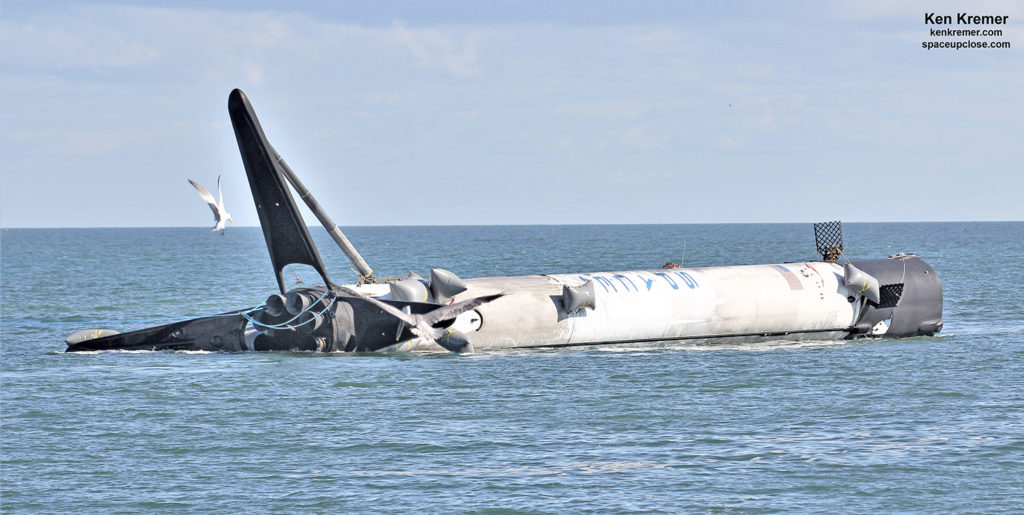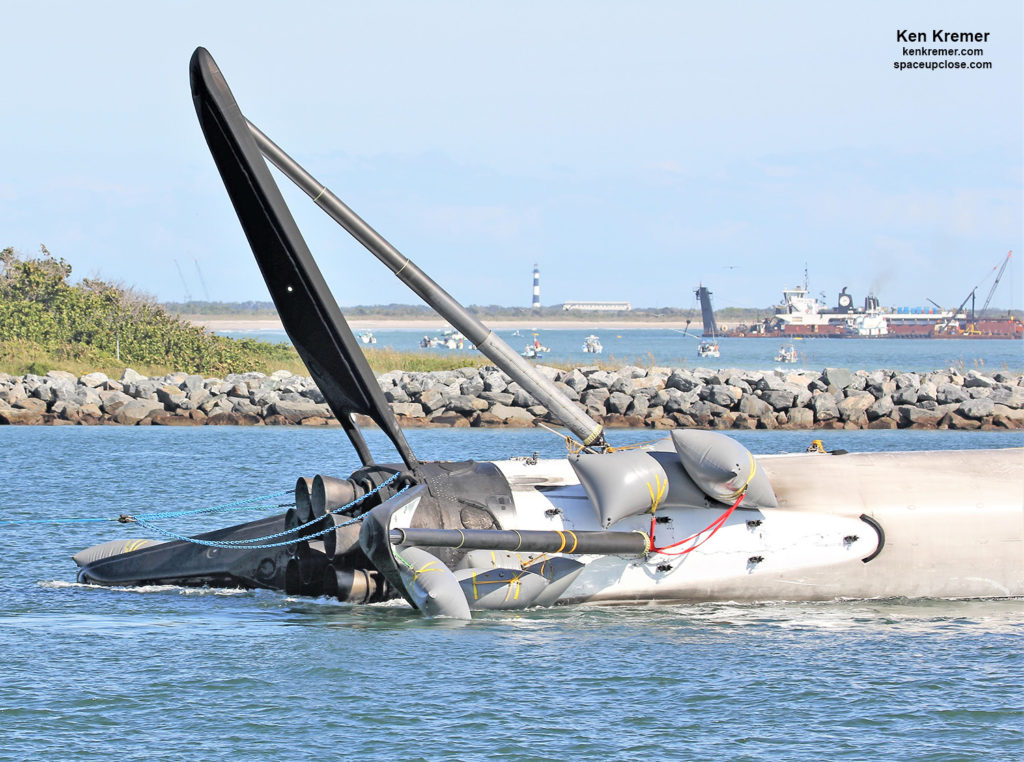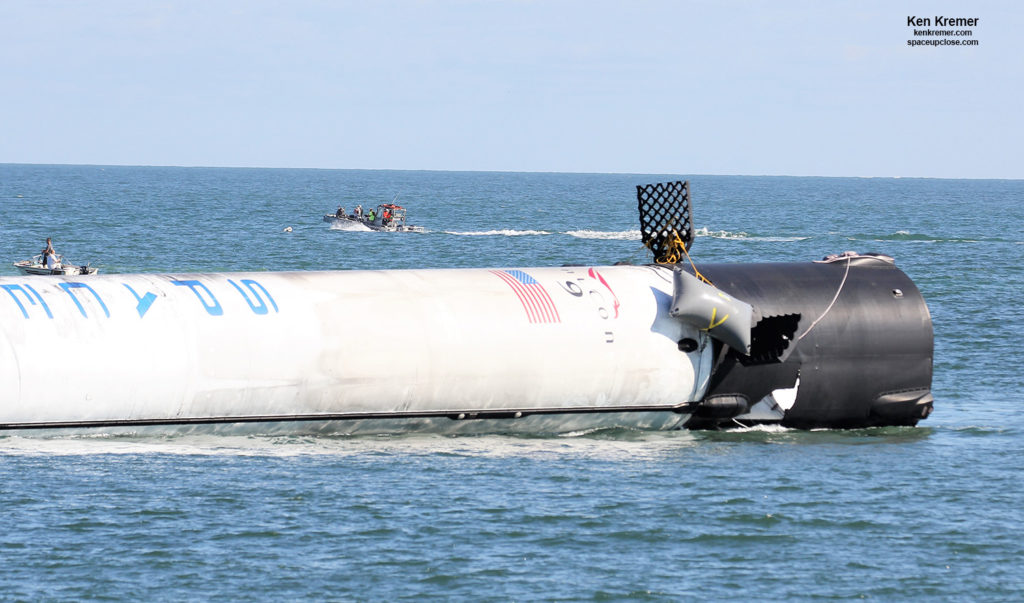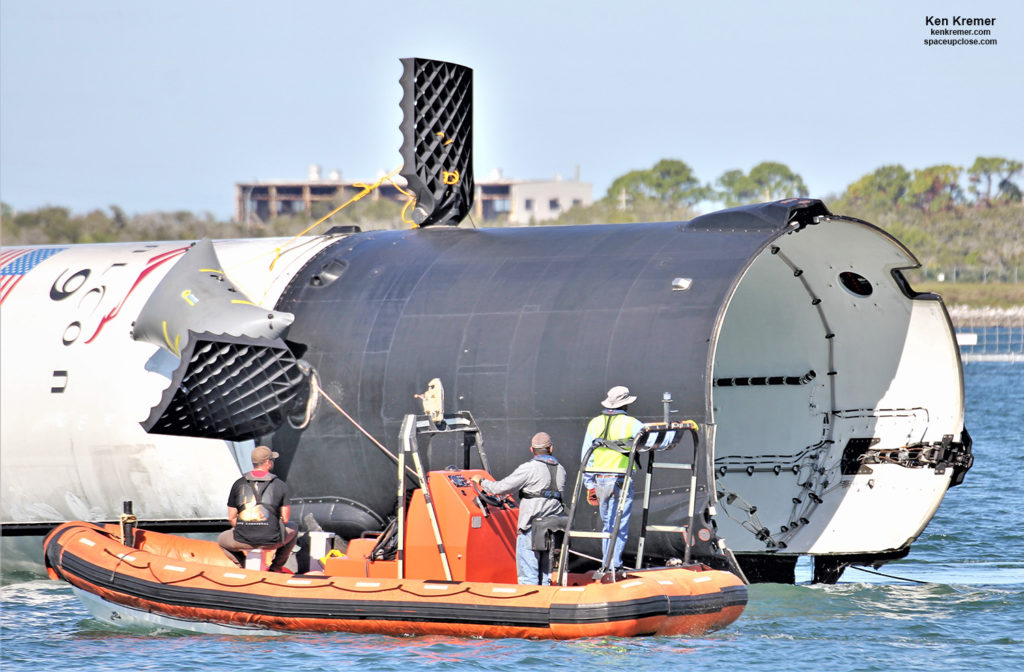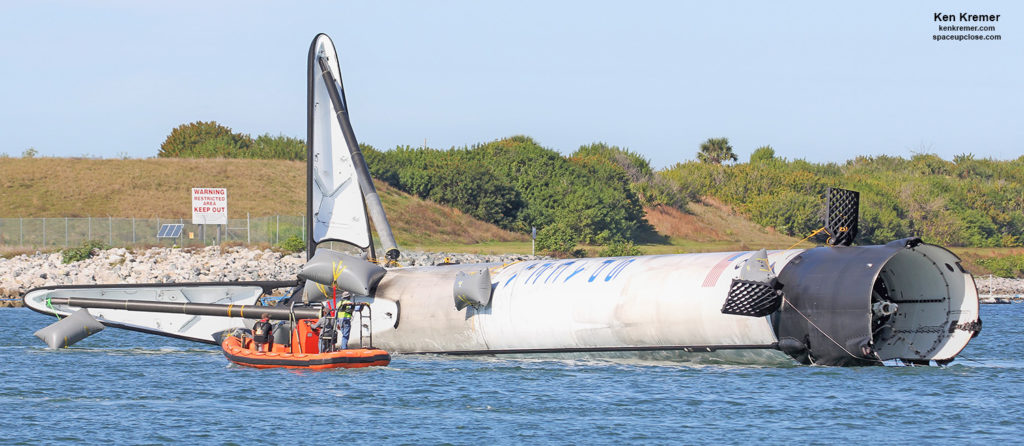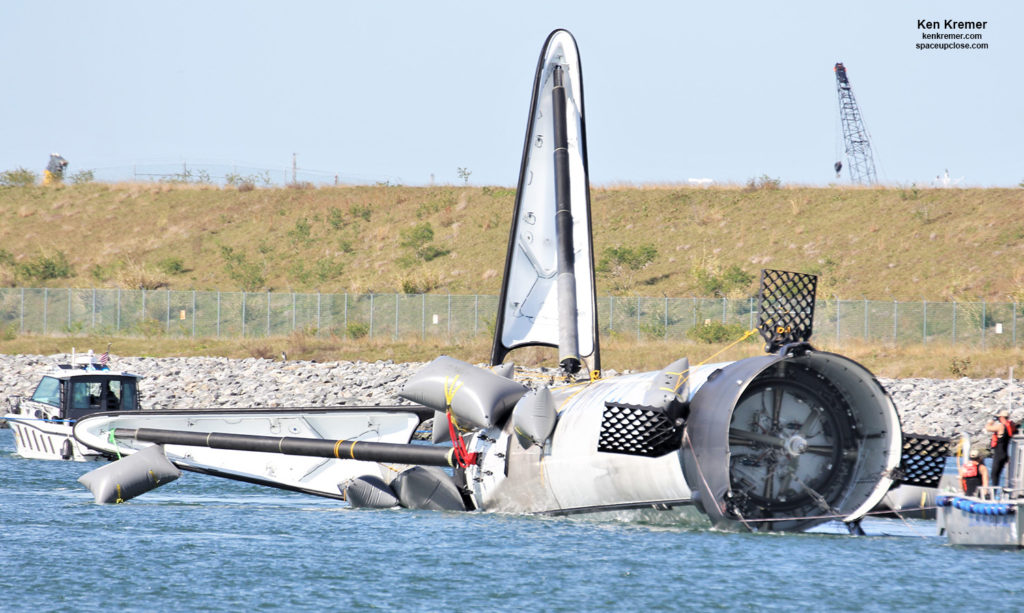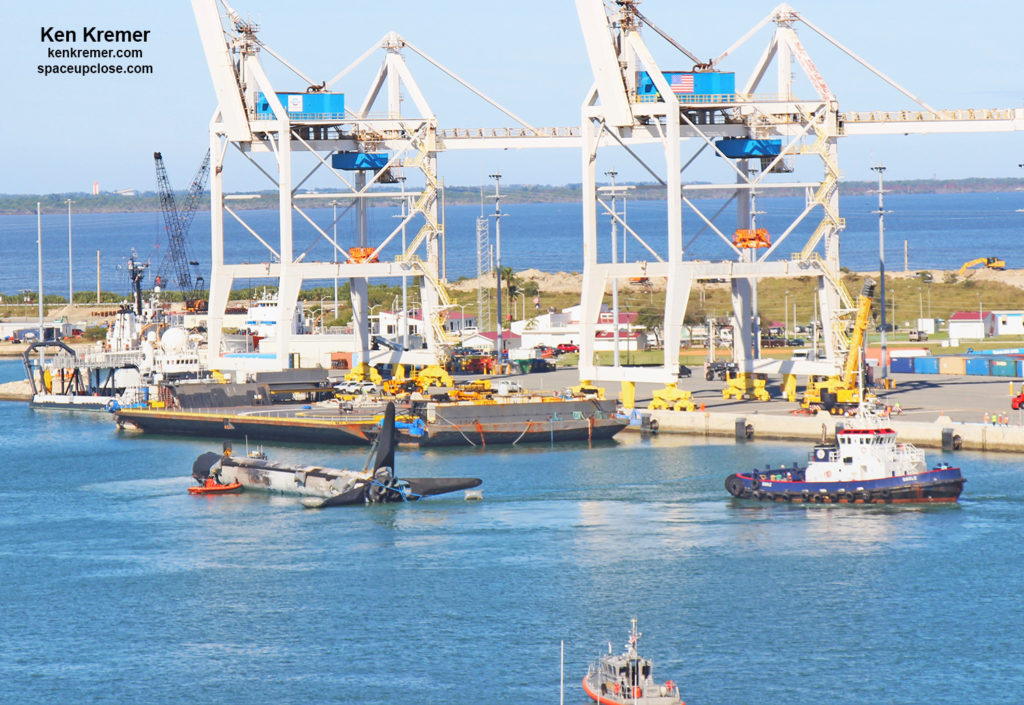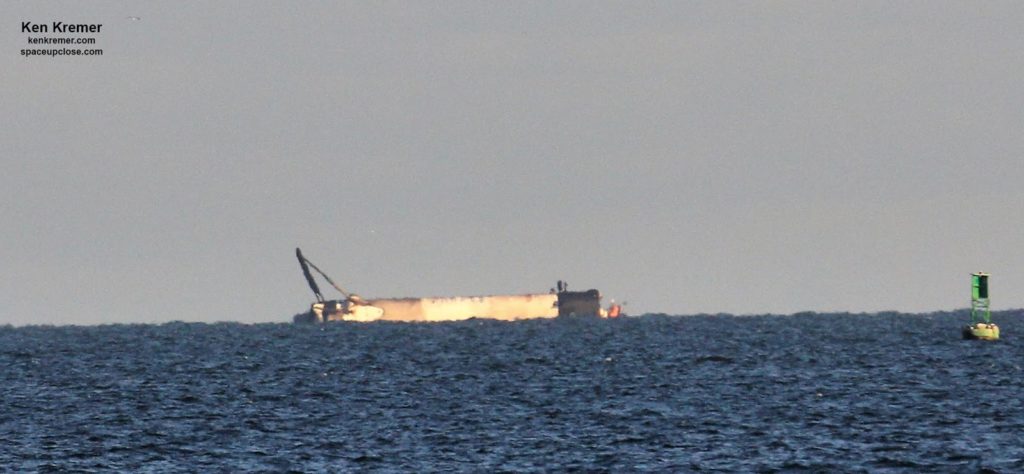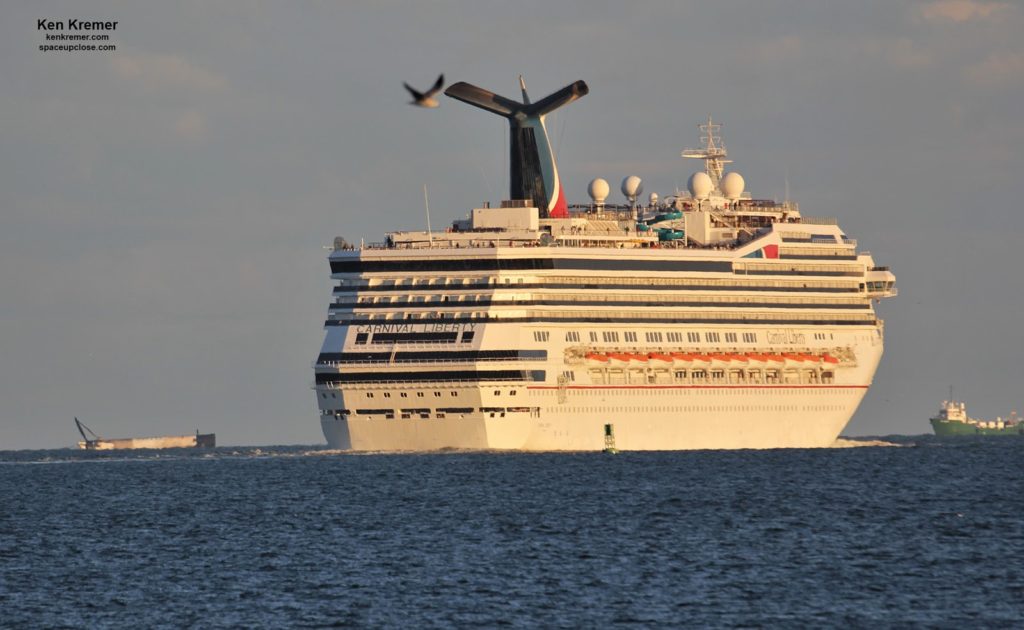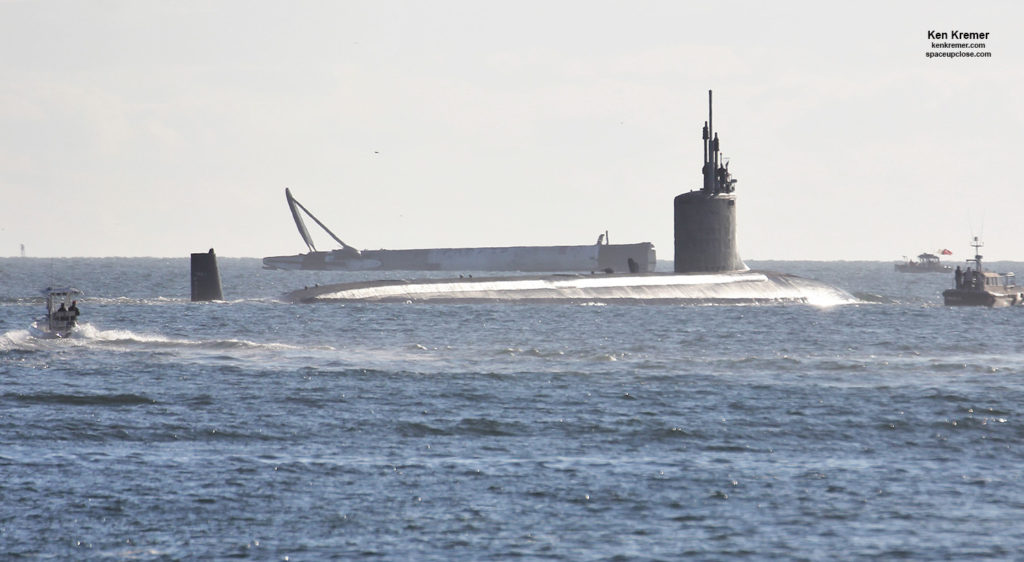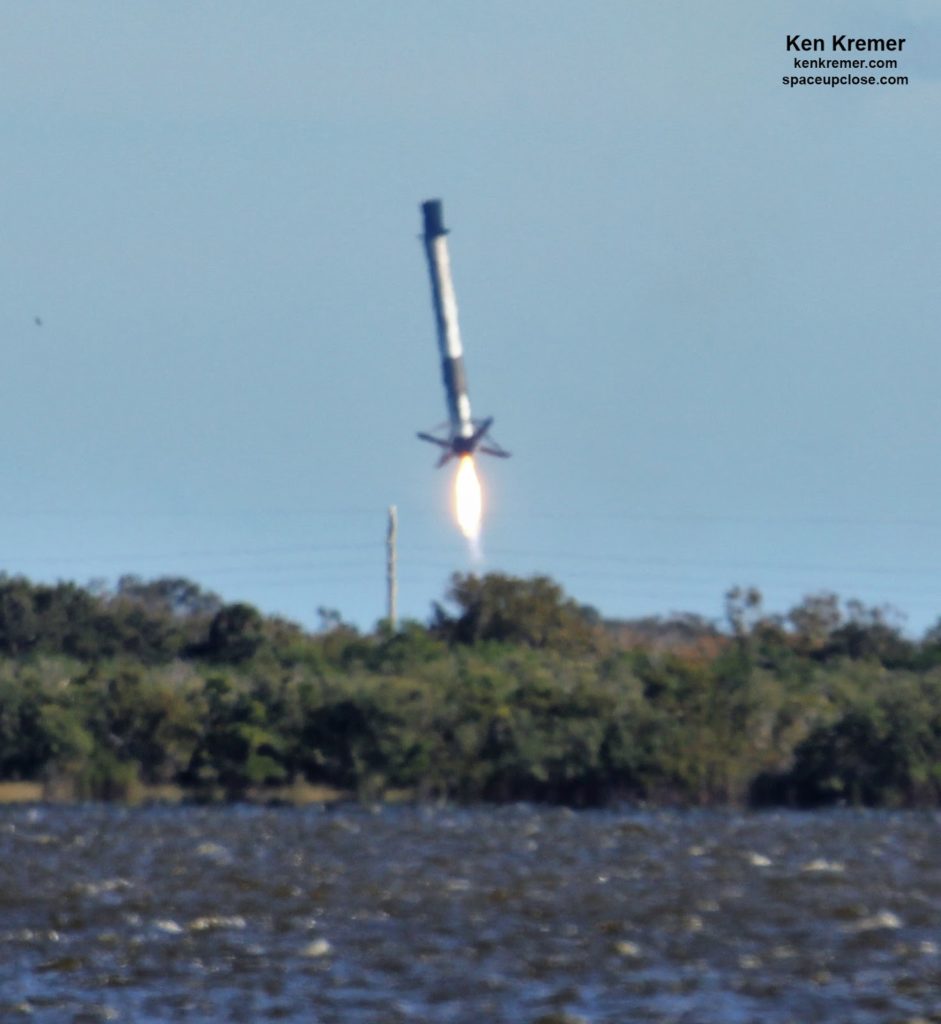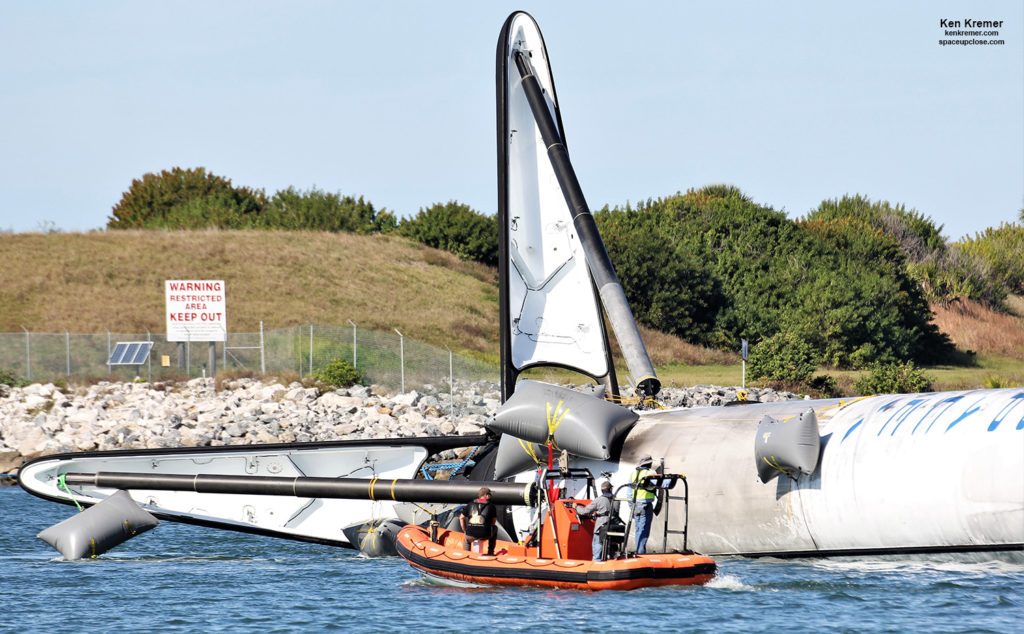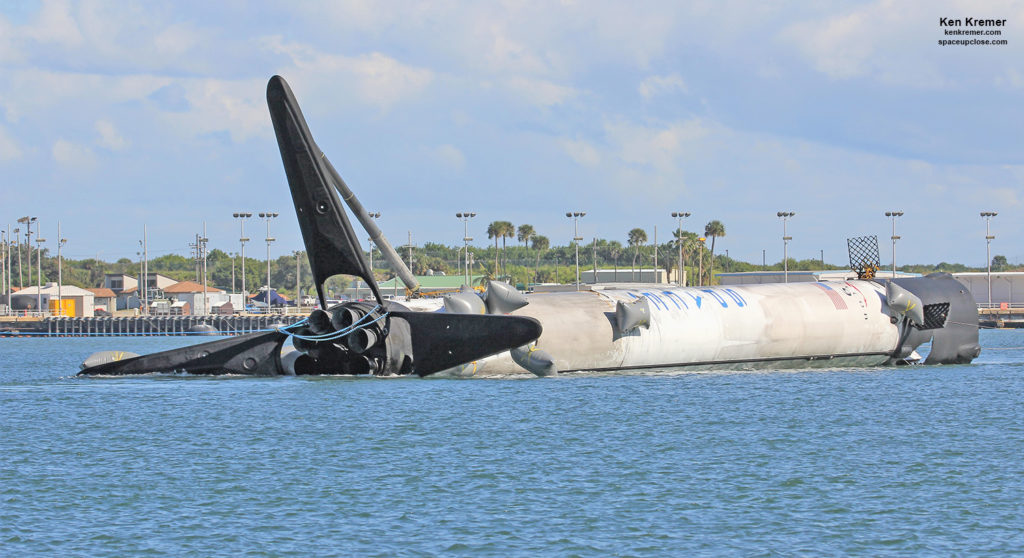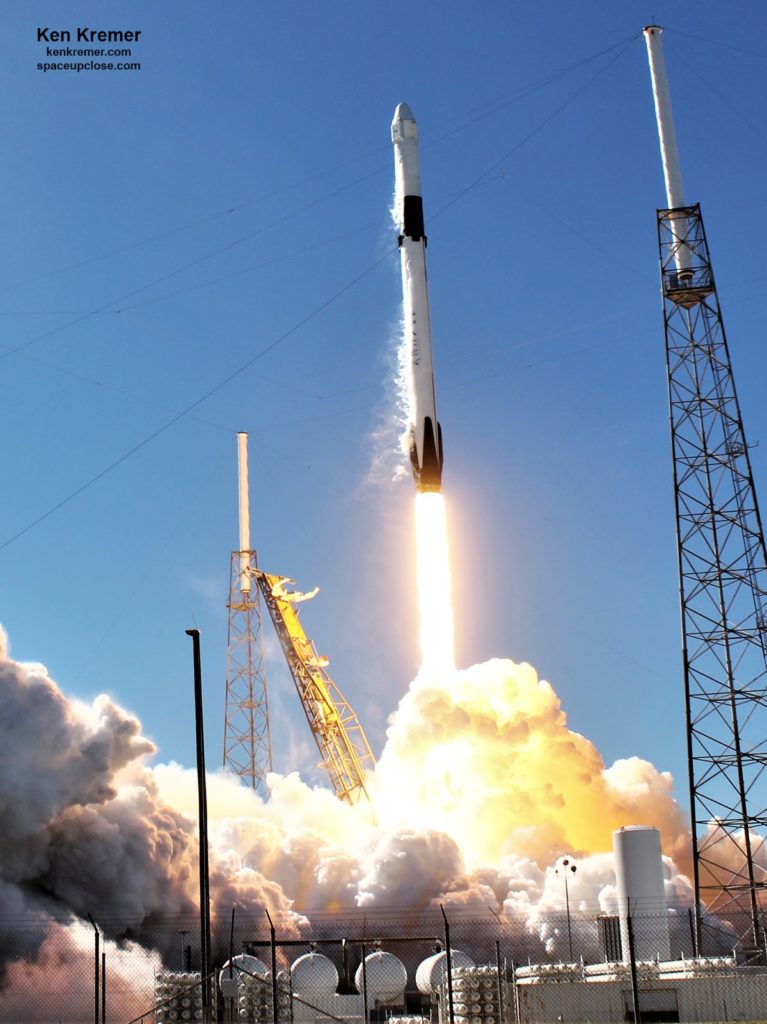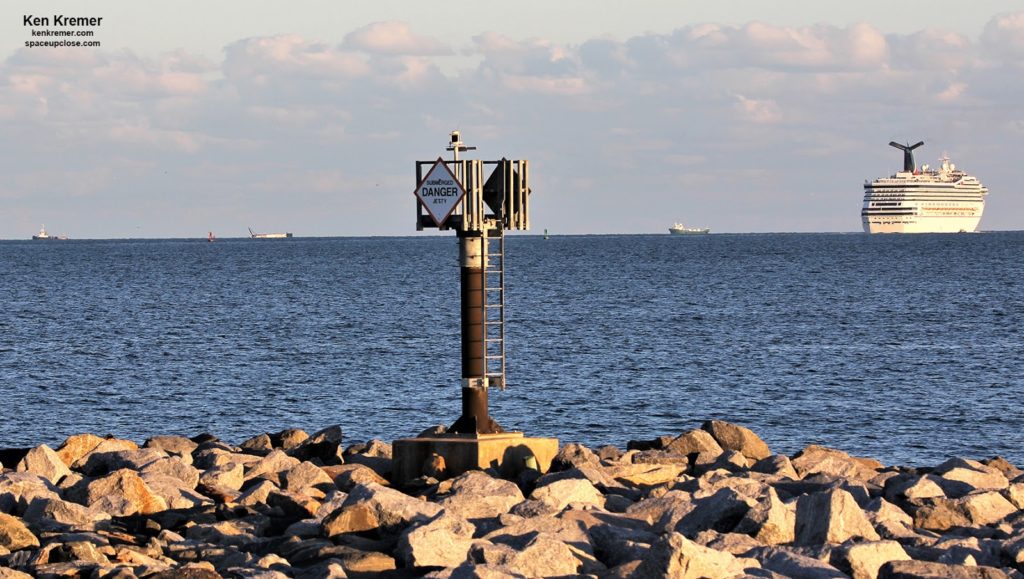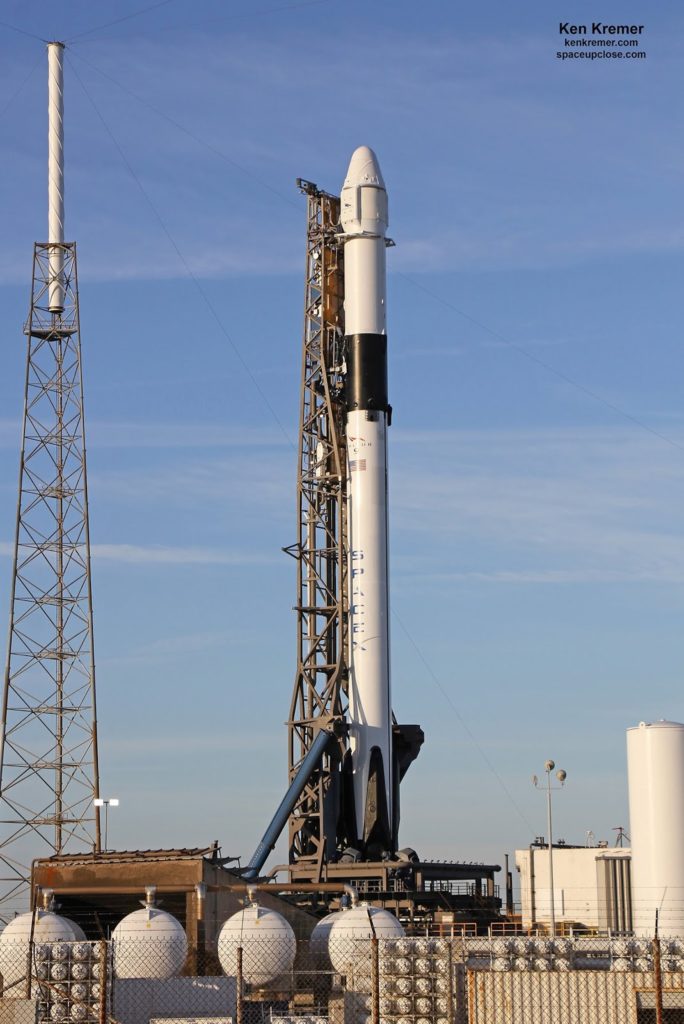Ken Kremer —SpaceUpClose.com &
RocketSTEM –7 December 2018
PORT CANAVERAL/KENNEDY
SPACE CENTER, FL – Two days after
successfully launching a Dragon cargo ship to the International Space Station (ISS) on Wednesday, Dec. 5, the floating spent Falcon 9 carrier rocket was
towed into Port Canaveral, FL, late Friday morning, Dec 7, after malfunctioning
and accomplishing an unplanned emergency aborted landing in the Atlantic Ocean,
tipping over and surviving horizontally as a remarkably intact sea worthy vessel.
The seemingly straight
out of science fiction event made for an absolutely otherworldly and absolutely
first of its kind sight – attracting the rapt attention of space media like
myself and colleagues and folks who just happened to be in the right place at
the right time.
gallery of Space UpClose eyewitness photos documenting the entire voyage from arrival
at port, traveling through the port, docking and hoisting onto land and dismantling
the landing legs. Click back for more
imagery as the gallery grows.
Falcon 9 first stage looked like a giant finned shark or alien sea creature with three of its four landing legs poking
out above the ocean’s surface as it approached
the mouth of Port Canaveral at Jetty Park Pier just after 11 a.m. EST Friday,
Dec. 7.
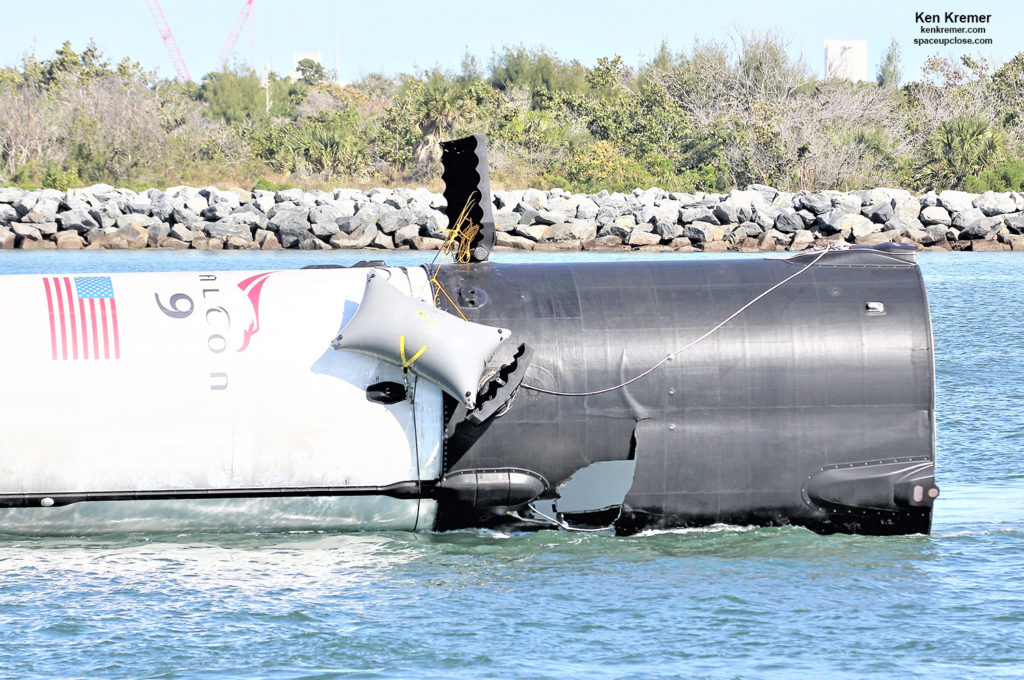 |
|
Ken Kremer/kenkremer.com/spaceupclose.com
|
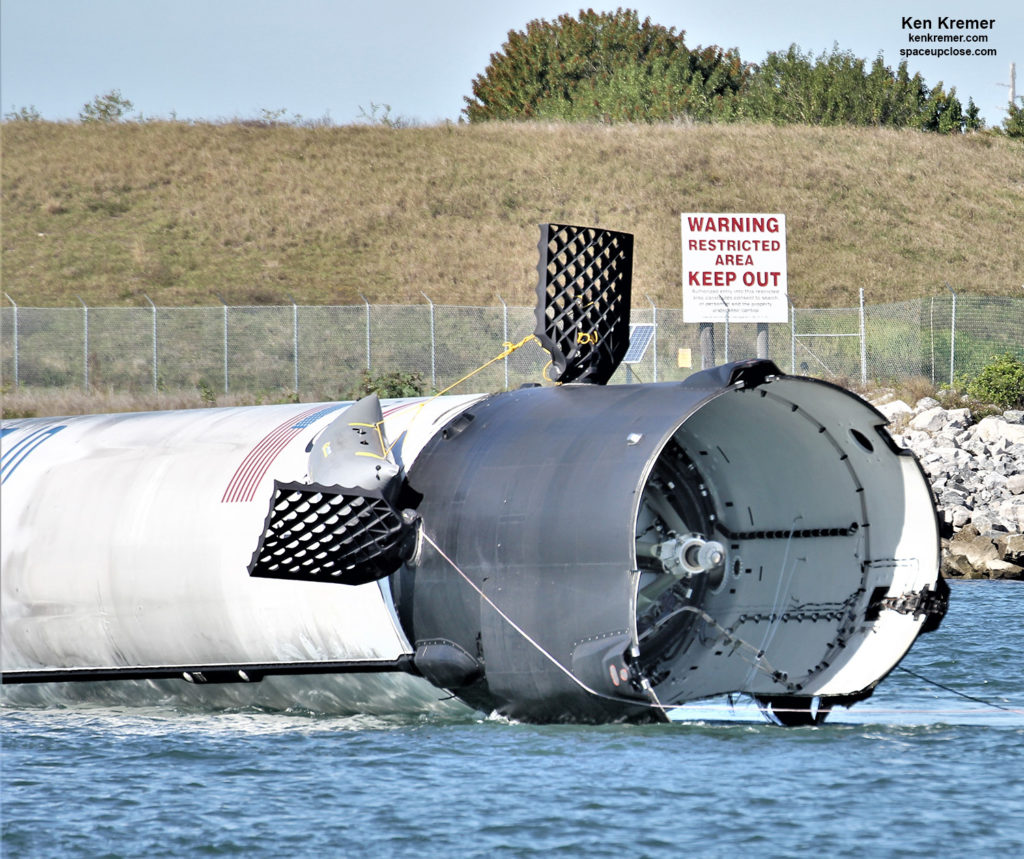 |
|
Ken Kremer/kenkremer.com/spaceupclose.com
|
The fourth leg was
missing. It either snapped off post splashdown or was hacked off by the diving team
from Logan Diving & Salvage who had attached flotation bags, cushion and
rope lines during its two day voyage back to port. In contrast all four
grid fins were intact.
angles of the Falcon 9 returning horizontally afforded totally unique photos
looking all around both sides of booster, looking up from the bottom with all 9
Merlin 1D engines, down from the top, and inside the core interstage and
landing legs. Quite an exciting and unexpected treat.
tugboat fleet actually arrived just outside the port channel mouth late Thursday
afternoon, but had to wait their turn in ling for normal higher priority Cruise
Ship traffic to enter and depart – see our amazing photos!
SpaceX also had to wait for the departure of the US Navy Nuclear Submarine recently
christened USS Indiana- see photos and separate story.
After completing its
primary mission of delivering the Dragon ship to orbit for NASA, the Falcon 9 first
stage was returning to Earth and targeting a soft touchdown back on land at Cape
Canaveral at its designated Landing Zone-1 – as SpaceX has done here multiple
times already over the past 2 years.
But instead we
witnessed something unexpected as the 15-story tall booster suddenly spun out of control for the first time during
its descent phase due to a hydraulic pump failure in one of four grid fins used
for steering – as I witnessed and reported here on launch day – and aborted to make
a safe splashdown in the Atlantic Ocean just a mile or so offshore of the
Florida coastline and away from populated areas.
After on board
autonomous guidance systems realized the booster would failing to make a vertical
touchdown back on land at Cape Canaveral Air Force Station, the engines of the plummeting
15 story tall booster finally regained control of the descent in the final moments
and retargeted the booster to accomplish an upright ‘soft landing’ at sea 8 minutes after liftoff –
just offshore in the ocean waters.
The booster was towed into
Port Canaveral at lunchtime Friday by the Eagle tugboat assisted by a small
fleet of SpaceX contracted ships.
It took about another
30 minutes for the floating Falcon to be towed through the narrow channel of
Port Canaveral to ultimately reach the same dock facility used by SpaceX after
returns of vertically landed boosters on top of the OCISLY drone ship. Those
occur some 400 mi (600 km) offshore and the most recent drone ship landed
booster was towed in port about three weeks ago.
We could see that the
booster survived with remarkable resilience. Except for the integrate at top
which was heavily damaged, cracked, broken, deformed significantly and missing
pieces.
After reaching the vicinity
of the docking slip, the fleet of ships and tugboats then gently nudged the
booster towards the dock seawall – right beside OCISLY which was also docked in
port.
Work crews then
surrounded the booster with a containment boom to limit pollution from residual
chemicals and particles potentially dislodging and floating free.
the dock crews could be seen hard at work attaching two slings around the core
stage for eventual hoisting out of the water using two hoisting cranes – near
the front and back.
The booster was finally
hoisted out of the channel late Friday evening and placed on two pedestals on
land.
With the return of
daylight the next morning, crews would begin removing all the floatation bags,
cushions and rope lines, and then the landing legs – see follow up story/photos.
The lunchtime Wednesday
launch of the Falcon 9 itself was spectacular and fully successful in starting the
Dragon CRS-16 spacecraft on its three day journey to the ISS.
The mission began with
the flawless blastoff
of the new SpaceX Falcon 9 rocket and Dragon CRS-16 commercial cargo freighter right
on time Wednesday afternoon December 5 as all nine first stage Merlin 1D engines roared to life and ignited
with 1.8 million pounds of liftoff thrust at 1:16 p.m. EST (1816 GMT) from Space Launch Complex 40 at Cape Canaveral Air Force
Station in Florida.
Watch my commentary about the successful launch
and ‘successful failure’ of the retargeted aborted landing here at Fox 35 News Orlando, FL:
The prior CRS-15 resupply flight successfully flew in June
from pad 40.
The two stage Falcon 9/Dragon rocket stands
about 213-feet (65-meters) tall.
To date SpaceX has successfully landed 32 1st stage
rockets by land and by sea. And they have reused 17 of those 15 story tall boosters
since the first relaunch in March 2017 relaunch for SES.
CRS-16 marks the 20th flight overall for SpaceX
in 2018 and the 4th ISS resupply mission for NASA in 2018.
Billion contract from NASA to launch 20 Dragon cargo missions to the orbiting outpost
through 2019 under the Commercial Resupply Services (CRS) agreement.
Watch for Ken’s
continuing onsite coverage of NASA, SpaceX, ULA, Boeing, Lockheed Martin, Northrop
Grumman and more space and mission reports direct from the Kennedy Space Center,
Cape Canaveral Air Force Station, Florida and Wallops Flight Facility,
Virginia.
and human spaceflight news: www.kenkremer.com –www.spaceupclose.com – twitter
@ken_kremer – email: ken at kenkremer.com
journalist and photographer based in the KSC area.
Ken’s photos are for sale and he is available for lectures and outreach events


